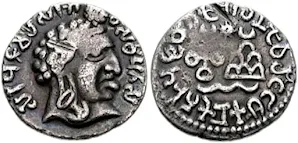SIRI-PULUMAVI SATAVAHANA DYNASTY COIN
This coin belongs to the Satavahanas dynasty king "Vashisthiputra siri-pulumavi".In the region of Satavahana rule. This coin is found in Vidarbha at the time of satavahanas.
History of satavahanas :-
SPECIFICATIONS:-
Coin type: Portrait type
Metal: Silver
Coin issue: (170-180AD)
Weight: 1.97 grams
Found place: PRATISHTHANPURA (in Maharashtra)
Rare: Extremely rare
OBSERVER SIDE:-
On the observer side, we can see the king facing the left side with a right side view with the king's curly hair and wearing a large ear ornament and the "Bhrami legend" around the king which says "Rano vasithiputasa".
REVERSE SIDE:-
On the reverse side, we can see the five symbols in the coin which are rare to see in any other dynasty coins, along with the Bhrami legend around the coin.
5 types of symbols on this coin are
1. Modified Ujjain symbol (as seen above).
2. Waves like a symbol
3. Sun
4. Crescents
5. 6 arched hills
6. The King's name also along with the symbols.
THE SYMBOLS EXPLAINED BELOW:-
1. Six arched hills:
It talks about the six hills in the Deccan plateau which is under the rule of the satavahanas.
2. Sun :
We can say that mostly in the olden "Vedic" ages to "now" we worship sin as God. So this symbol may be used in the satavahanas dynasty.
3. Wave-like line:
Which indicates the rivers.
4. Modified ujjain symbol:
Satavahanas used the ujjain symbol in their coin by modifying it.
5. Crescent:
These symbols may look like ships because most satavahanas used different coins with symbols to even trade with other kingdoms through the rivers.
NOTE:-
But according to some scripts they say that the first king of satavahanas "Simuka" made "partisan pura" their capital.
After that, they changed their capital from Pratisthanpura to "Amaravati '' in Andhra. so we don't have perfect evidence to say what is the capital of satavahanas.
CONCLUSION:-
THE SATAVAHANA KING SIMUKA USED TO WORK AS A WARFARE MINISTER UNDER KING "ASHOKA ''. AFTER THE ASHOKA'S LEFT HIS KINGDOM THE SMALL KINGS UNDER HIM MADE THEM INDEPENDENT RULERS.
Note:
IF YOU WANT TO KNOW ABOUT ALL THE ANCIENT COINS OF INDIA CLICK THE BELOW LINK,
THANK YOU FOR VISITING MY BLOG.



